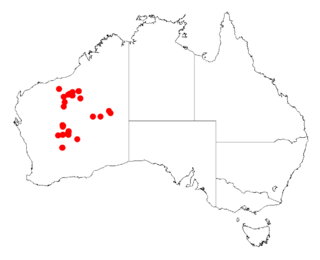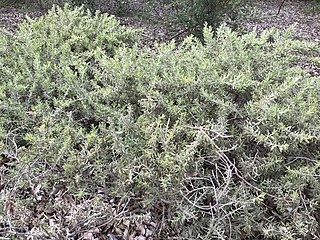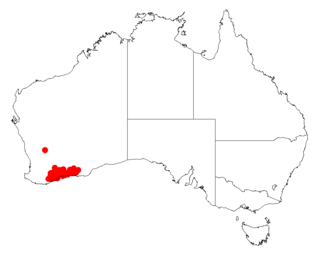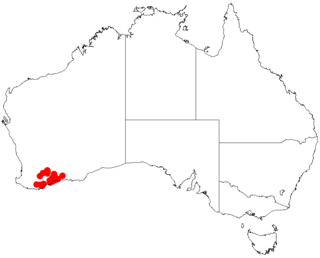
Acacia brachypoda, known colloquially as western wheatbelt wattle or Chinocup wattle, is an endangered species of Acacia restricted to a small locality in western Australia's wheatbelt.

Acacia argutifolia, commonly known as the East Barrens wattle, is a shrub belonging to the genus Acacia and the subgenus Phyllodineae.

Acacia adenogonia is a shrub of the genus Acacia and the subgenus Plurinerves that is endemic to north western Australia.

Acacia anfractuosa is a shrub or tree of the genus Acacia and the subgenus Plurinerves that is endemic to Western Australia.

Acacia ascendens is a shrub of the genus Acacia and the subgenus Plurinerves that is endemic to a small area in south western Australia.

Acacia aulacophylla is a shrub of the genus Acacia and the subgenus Plurinerves that is endemic to western Australia.

Acacia auratiflora, commonly known as the orange-flowered wattle, is a shrub of the genus Acacia and the subgenus Plurinerves. It is listed as an endangered species.

Acacia balsamea, commonly known as balsam wattle, is a shrub of the genus Acacia and the subgenus Plurinerves.

Acacia declinata is a shrub of the genus Acacia and the subgenus Plurinerves that is endemic to an area along the south coast in south western Australia.

Acacia dissona is a shrub of the genus Acacia and the subgenus Plurinerves that is endemic to an area of south western Australia.

Acacia donaldsonii is a shrub of the genus Acacia and the subgenus Plurinerves that is endemism in an area of south western Australia.

Acacia lanuginophylla, or woolly wattle, is a shrub of the genus Acacia and the subgenus Plurinerves that is endemic to south western Australia. It is currently listed as a vulnerable species according to the Environment Protection Biodiversity Conservation Act 1999.

Acacia patagiata, also commonly knowns as salt gully wattle, is a shrub of the genus Acacia and the subgenus Plurinerves that is endemic to south western Australia.
Acacia pelophila is a shrub of the genus Acacia and the subgenus Plurinerves that is endemic to a small area along the west coast of western Australia.

Acacia pharangites, commonly known as Wongan gully wattle, is a shrub of the genus Acacia and the subgenus Plurinerves that is endemic to a small area of south western Australia and is listed as endangered according to the Environment Protection and Biodiversity Conservation Act 1999.

Acacia sciophanes, commonly known as the Ghost wattle or Wundowlin wattle, is a shrub of the genus Acacia and the subgenus Plurinerves that is endemic to a small area in south western Australia. In 1995 it was declared as rare in 1995 according to the Western Australian Wildlife Conservation Act 1950 and is listed as endangered under the Environment Protection and Biodiversity Conservation Act 1999.

Acacia speckii is a shrub or tree of the genus Acacia and the subgenus Plurinerves that is endemic to a small area in central western Australia.

Acacia tetanophylla is a shrub of the genus Acacia and the subgenus Plurinerves that is endemic to an area of south western Australia.

Acacia undosa is a shrub of the genus Acacia and the subgenus Plurinerves that is endemic to an area of south western Australia.

Acacia vittata, commonly known as Lake Logue wattle, is a shrub of the genus Acacia and the subgenus Plurinerves that is endemic to a small area in western Australia.




















